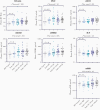Abnormal Levels of Some Biomarkers of Immune Activation Despite Very Early Treatment of Human Immunodeficiency Virus
- PMID: 32915986
- PMCID: PMC8136975
- DOI: 10.1093/infdis/jiaa580
Abnormal Levels of Some Biomarkers of Immune Activation Despite Very Early Treatment of Human Immunodeficiency Virus
Abstract
Background: Despite early antiretroviral therapy (ART), ART-suppressed people with human immunodeficiency virus (HIV) (PWH) remain at higher risk for infections and infection-related cancers than the general population. The immunologic pathways that remain abnormal in this setting, potentially contributing to these complications, are unclear.
Methods: ART-suppressed PWH and HIV-negative controls, all cytomegalovirus seropositive and enriched for HIV risk factors, were sampled from an influenza vaccine responsiveness study. PWH were stratified by timing of ART initiation (within 6 months of infection [early ART] vs later) and nadir CD4+ T-cell count among later initiators. Between-group differences in kynurenine-tryptophan (KT) ratio, interferon-inducible protein 10, soluble CD14 and CD163, soluble tumor necrosis factor receptor 2, interleukin 6, and soluble urokinase plasminogen activator receptor were assessed after confounder adjustment.
Results: Most participants (92%) were male, reflecting the demographics of early-ART initiators in San Francisco. Most biomarkers were higher among later-ART initiators. Participants in the early-ART group achieved near-normal soluble tumor necrosis factor receptor 2, interleukin 6, and soluble urokinase plasminogen activator receptor levels, but substantially higher KT ratio than those without HIV after confounder adjustment (P = .008). Soluble CD14, soluble CD163, and interferon-inducible protein 10 trended similarly.
Conclusions: While early-ART initiators restore near-normal levels of many inflammatory markers, the kynurenine pathway of tryptophan catabolism remains abnormally high. Because this pathway confers adaptive immune defects and predicts tuberculosis and cancer progression, this it may contribute to persistent risks of these complications in this setting.
Keywords: 3-dioxygenase-1; HIV; IP-10; antiretroviral therapy; immune activation; indoleamine 2; inflammation; kynurenine; sCD14; sCD163; tryptophan.
© The Author(s) 2020. Published by Oxford University Press for the Infectious Diseases Society of America. All rights reserved. For permissions, e-mail: journals.permissions@oup.com.
Figures


References
-
- Danel C, Moh R, Gabillard D, et al. . A trial of early antiretrovirals and isoniazid preventive therapy in Africa. N Engl J Med 2015; 373:808–22. - PubMed

